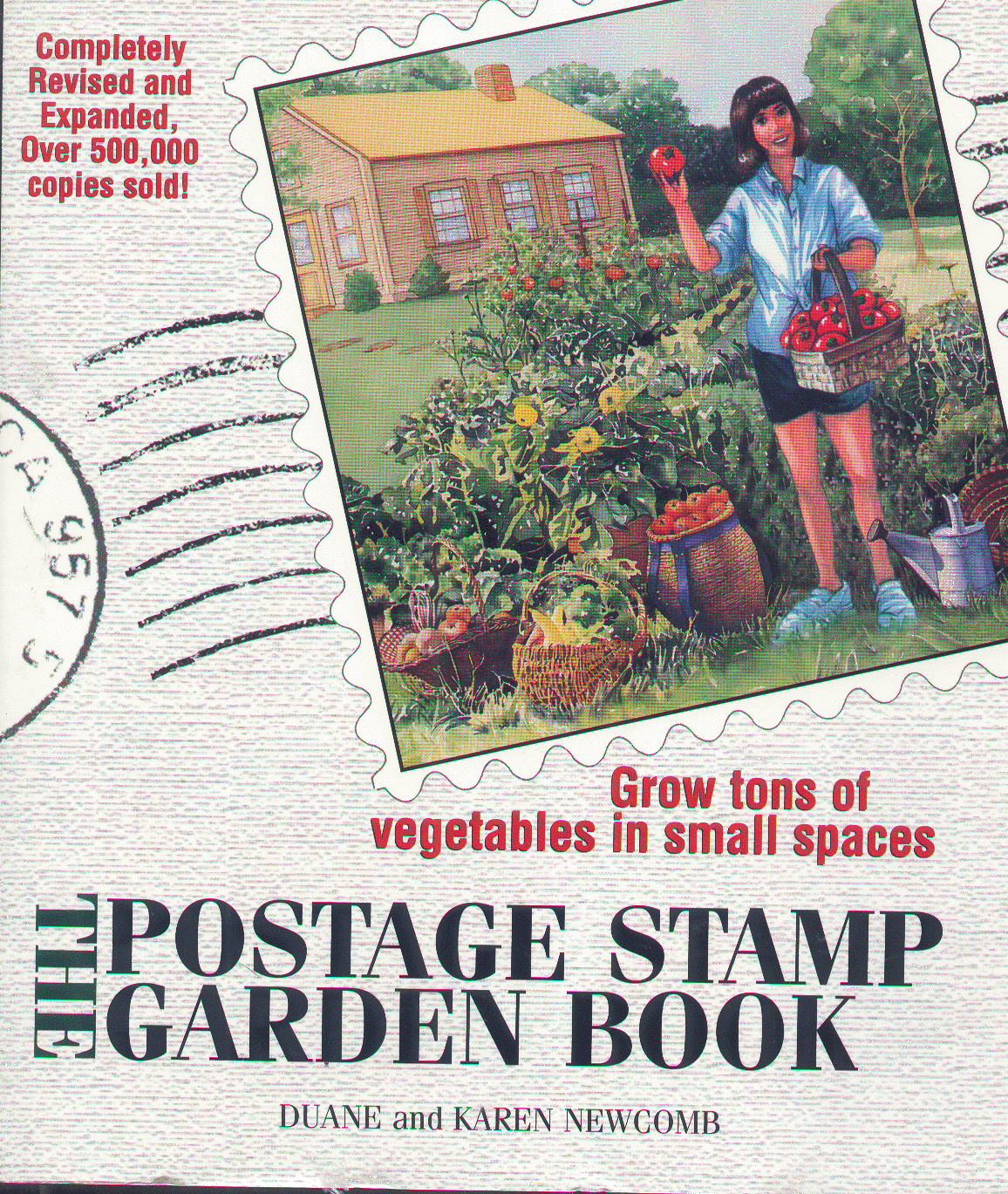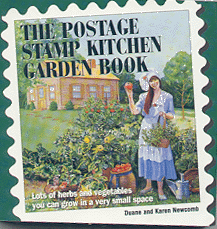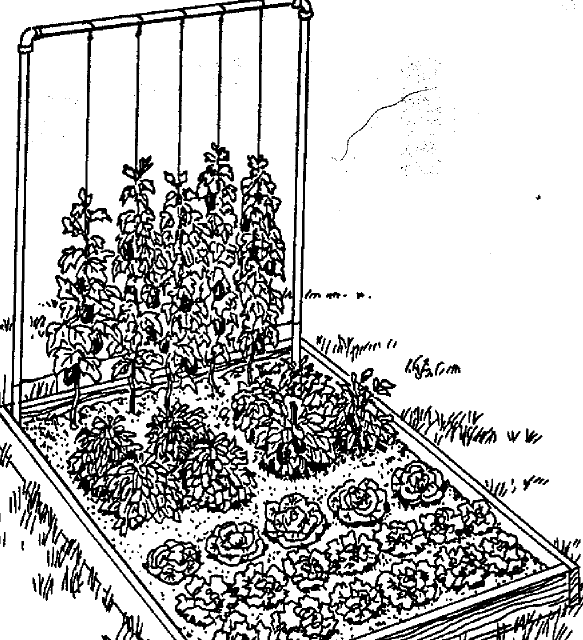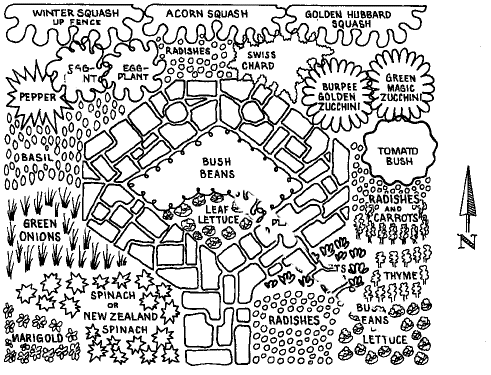|
Welcome to The Postage Stamp Gardening Site!
A poastage stamp garden is a small area that
can produce a bounty of herbs and vegetables. It is also an ornamental garden of herbs, annuals, perennials and shurbs
in the ground or in containers that makes full use of a very small space. With today's small lots gardeners complain
that they are short on both time and garden space. Postage Stamp gardening solves both of these problems. Anyone following
intensive practices can produce tremendous amounts of vegetables in a very small space. or turn a small side yard into an
enchanted garden space.
Are you a Postage Stamp gardener? We'd
love to have you send us a picture (jpeg) of your garden. Tell us which area you live in, how your garden did and
a picture of yourself as well. We'll put you and your garden on the Postage Stamp Garden web site.


The Postage Stamp Garden Book: How to Grow All the Food You Can Eat in Very Little
Space Using Intensive Gardening Techniques.
If you've never tried vegetable gardening, if you've tried and it just didn't work out, or even if you consider yourself
a backyard gardening techniques in this book will help you to grow more healthy vegetables in less space and with less hassle
than you ever thought possible. Over 250,000 copies in print.
Here's What Readers Say: Excellent resource for those new to gardening!, February 13, 2000
|
Reviewer: Dawne B from San Diego, CA | I
am a gardening dummy and found this book to be a real "bible" for me when starting my first patio and small in-ground garden
plot. This books really lays it all out for you. They go into detail about how to do things organically, as well, if you want
to go to all the trouble. But they also tell you the easier alternatives (like buying store organic fertilizer). I would recommend
this book to new gardeners as well as experienced ones -- lots of tips on how to get all types of vegetables producing a lot
of food for you, when to plant, what to plant with, etc.
Purchase the Postage Stamp Garden Book now from Amazon.com, click here

The Postage Kitchen Garden Book: A reader from Newport
Beach, CA Good information for my small vegetable gardening purposes. Informative charts covering seed germination,
soil nutrient deficiency, spacing suggestions, heat content of various chiles and more. Especially liked the many layout suggestions
for an intensive garden. Many sources for specific vegetables in six different kitchen gardens including vegetarian, French
and Mexican. Clever ideas for container gardening. My only negative comment: I found the small size of the book to be awkward.
Purchase the Postage Stamp Kitchen Garden Book from Amazon.com, click here
Check Out the other books in the Postage Stamp Gardening Series
- The Vegetable Factory
- Small Space Big Yield
- The Apartment Farmer
- The California Vegetable Patch
Click here for The Postage Stamp Garden Series and other gardening books
Amazon.Com
Want your books autographed? Send your copy of the Postage Stamp Garden Book, or the Postage
Stamp Kitchen Garden Book to me with return postage to PO Box 3236, Rocklin, CA 95677. I will return it to you.
Duane Newcomb
Purchase your Postage Stamp Gardening supplies from our gardening store.
Click here for the Postage Stamp Gardening Store
Read the first chapter of the Postage Stamp Garden Book
How to Plan Your Intensive Postage Stamp Garden
There are few things more fun than planning the
garden that youre going to grow next season.
The best wintertime garden dreamers make up dozens of drawings of what their next garden is going to look like. We suggest that you do it too. After
all, things always go better with a plan. A good plan keeps your mistakes to
a minimum by giving you some idea in advance of where to put your garden, what to plant in it, how much space to allocate,
and what shape it should have.
Where
to Put Your Garden
Of course the first thing to do in planning your garden is to decide where to put it.
Actually your plants don't really care where they grow so long as you give them a lot of tender loving care.To a vegetable, tender loving care is good fertile soil, enough water, and whatever heat
and daylight it needs. In most cases, vegetables need direct sunlight, a requirement
you can satisfy practically anywhere. We have a bachelor friend who lives
in one room behind a drugstore and grows a productive little garden in a sunny 5-by-9-foot space between the back door and
a brick wall. By following a few rules you can certainly do as well in your own
backyard. The main rule to consider is this: most vegetables need minimally about
six hours of direct sunlight. If they get less, you're in trouble. So long as it receives this minimum amount of direct sunlight every day, you can put
your garden almost anywhere. Consider though, that you can never give your
warm weather vegetables (tomates, squash, peppers) too much sum. Cool weather
vegetables (lettuce, greens, cabbage), will tolerate a little shade.
There are a few other placement considerations.
Keep your garden bed at least twenty feet away from shallow-rooted trees like elms, maples, and poplars. Not only will the foliage of these trees block out the sun but their roots will also compete for water
and nutrients. Generally, tree roots take food from the soil in a circle as far
out as the trees widest-reaching branches, and plants usually do poorly within this circle.
Dont put your garden in a depression that will collect standing water or near a down spout where the force from a sudden
rain can wash out some of your plants.
Try to place your garden near a water outlet. This eliminates having to
drag a hose long distances. Also try to place your garden as near the tool storage
area as possible.
How to Design Your Garden
By proper placement of individual vegetables in your Intensive Postage Stamp garden you can produce extremely large
quantities of vegetables in an extremely small space. The following are IPS (Intensive
Postage Stamp) planning rules that will help you obtain maximum results.
1. Plant tall vegetables on the north end of your garden to avoid shading
the smaller crops, and plant the other vegetables in descending order of size down toward the south end of the garden.
2. Never mind about planting in rows.
In an IPS garden you scatter your seeds to use all the space in your garden, and then thin out the seedlings (the small
plants) as they come up. If you set out seedlings rather than seeds, space them
without concern for straight rows. What you want is to have the mature plants
just touch one another on all sides. (In Chapter 6 well discuss seeds and seedlings,
as well as the best spacing for various plants).
3. If your plot is large--say, 10 by 10 feet or 8 by 8 feet--you can plant
different types of vegetables in separate squares or rectangles. In plots more
than 5 or 6 feet wide youll need pathways in order to reach all your plants. However, if the plot is narrow or small, simply block out irregular groups of vegetables
and fill in the spaces any way you wish.
4. For root vegetables (such as carrots and beets), leafy vegetables (such
as lettuce and spinach), and corn you need a special planning. The areas
chosen for each of these vegetables should be subdivided into thirds or fourths, and each subsection should be seeded or planted
a week to ten days apart. In this way you get continual harvests: as one subsection
finishes bearing mature vegetables, another begins. You dont have this problem
with plants like tomatoes and cucumbers, of course, which bear from the same plant over a long period of time. After you've harvested a subsection of leafy or root vegetables, you can replant that subsection. That way you're making your garden produce everywhere all the time.
5. Use the air space above your garden as much as possible. Train tomatoes,
cucumbers, and other vines and trailing plants up trellises, fences, poles, or whatnot, so that they wont run all over
your garden bed, crowding out the other plants. The better you get at this vertical
growing, the more things youll be able to pack into your IPS garden. (I'll give
you several methods for doing this in the detailed sections on each vegetable, Chapter
7).
6. Dont limit yourself necessarily to vegetables. We always include marigolds and some herbs in our garden. You'll
love the fragrance and color of a vegetable garden grown this way,...and, equally important, many veteran gardeners feel that
herbs and some flowers have a tremendous beneficial effect on garden health. (Well
get to all this in Chapter 8.)

Garden Plans You Can Use
In the next few pages are various plans for some Intensive Postage Stamp gardens.
The plans are intended as guidelines or possibilities only and should of course be modified by your own experience
to fit your needs. For one thing, you needn't limit yourself to conventional
rectangles. Choose almost any shape for your garden that you wish--square, rectangular,
triangular, circular, kidney-shaped,...you name it. Give vegetables water,
sun, the right amount of heat, and good soil, and away they go. The shape of
the garden generally doesn't mean a thing to them.
The
Regular Flowerbed Garden
Who says that you have to grow a formal vegetable garden? Nobody, right? Not only can you mix vegetables
with flowers in any flower bed, but a lot of gardeners will tell you that flower beds are really the natural place to grow
vegetables. A friend of ours, who follows this theory, produces great quantities
of vegetables. Her showy cabbage grows by itself, in a conspicuous spot. A number of vegetables make up the flower bed borders.
Corn grows in the corner in one big bunch. Vine plants grow up the back
fences. Its all very attractive and amusing.
Here are some rules that she gave us which I think youll find helpful in vegetablizing your own flower beds:
1. Plant vines such as cucumbers and small melons against the walls. Plant
beanstalks against a wall or stake them up. Plantings like this give your garden
an especially lush look.
2. Use lettuce (especially leaf lettuce) and Swiss chard as a flower bed
edging. Grow head lettuce just back of this.
3. Plant root crops in small sections.
4. Plant cabbage where youre looking for a show-off.
5. Plant corn in a good sunny corner.
A 4-by-6 plot with plants 10 inches apart will give you a good crop.
6. Use peppers as an ornamental where they compliment your other plants.
4-by-4
Boxed Gardens
For some reason, 4-by-4-foot boxed gardens spark the imagination of a lot of people, and we see more of them around
every year. Theyre neat, clean and easy to handle. You can walk all the way around them; you can thin the plants without getting dirty; and you can have
as many as you want in any arrangement you like--one or two, or a bunch.
Actually a boxed garden is not really a box with a bottom. Its more of
a frame. To make one, all you have to do is measure out a 4-by-4-foot space,
prepare the soil, and then frame the space with standard 2-by-4 planks set slightly into the soil to hold them in place. You can nail the corners for greater security if you wish. A 4-by-4 box like this is so much easier to handle that it appeals to our sense of energy conservation. There have been times when we didn't want the gigantic task of putting together a
big garden all at once; yet could spade up a 4-by-4 bed, put a frame around it, and plant it in about half an hour. Then, over the next several weeks, wed make up our entire garden one 4-by-4 bed at a time.
Generally we plant one or two vegetables in each of these small beds, with corn planted in three separate beds
about two weeks apart. We split most beds in two, planting a different vegetable
in each section--half to spinach, half to carrots, or whatever. These sections
we also subdivide into thirds which can be planted two weeks apart. We plant
all root and leafy vegetables this way. We train cucumbers, cantaloupe, beans,
and other vines and trailers up stakes, trellises or cages (see Chapter 7).
Now that weve explored some of the things that you should consider in planning the layout of your IPS garden, we can
now turn to the soil itself--what its like and how we can convert it into good fertile earth that will turn out
an abundance of vegetables. These things we consider in the next two chapters.
To go to chapter 2 click below.

A 10 by 7 foot Intensive Vegetable Garden
Gardening
experts, Duane and Karen Newcomb have written 10 gardening books. Their first effort, The
Postage Stamp Garden Book sold over 500,000 copies. The Newcomb vegetable gardening books include The Postage Stamp Kitchen Gardening
Book, The Backyard Vegetable Factory, The California Vegetable Patch, The Apartment Farmer, The Complete Vegetable Gardening
Sourcebook, Rx for Your Vegetable Garden, Small Space, Big Harvest, and others.
Duane Newcomb has a background in horticulture,
forestry and botany and is considered a top expert in intensive small-space gardening.
Karen Newcomb is a top vegetable variety and
intensive gardening expert. She prides herself in being able to find almost any vegetable variety that exists. As a team,
they have been called America's Small Space Vegetable Gardeners.
Duane Newcomb has written 32 books and has promoted
his and Karen's garden books on radio and television around the country. Together they are putting together a self syndicated
Kitchen Gardening Column to be launched during the spring of 2003.
Buy your Postage Stamp Gardening supplies form us through Gardener's Supply Company. While they carry other items they
also carry the organic items that we reccomend, plus composters and a lot more. Buy with your credit card through their secure
site.
The Postage Stamp Garden Store
|




